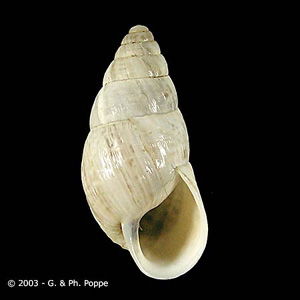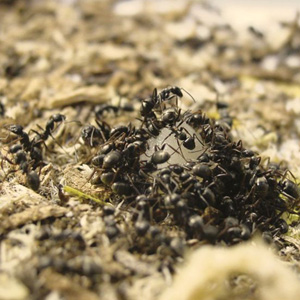Interactions
As aforementioned, Dicrocoelium dendriticum is classified as a parasite. In order for a symbiosis to be classified as parasitism, one organism, the parasite, benefits from the relationship at the expense of another organism, the host. Throughout its entire life cycle, this organism relies on its parasitic behaviors in order to live and reproduce, which can be very detrimental to its host. The hosts can include land snails, field ants, ruminants, and even humans.
There are over one hundred species of land snails that have proved susceptible to
Dicrocoelium dendriticum, including many from class Gastropoda
(Allogona
profunda,
Euconulus fulvus,
Neohelix solemi,
Strenotrema exodon,
Webbhelix multilineata), family Helicidae, and genus
Zebrina as well as Cernuella (Manga-Gonzalez 2001). Snails become infected after ingesting eggs excreted by the definitive host through fecal matter. As the parasite’s new intermediate host, the snail provides a hatching, transformation, and reproduction area for the larvae of the fluke. As mentioned in the
Life Cycle page, the snail is extremely vital for the reproductive success and sustainability because the egg’s process of hatching and releasing the miracidia only occurs in host land snails. The age, species, overall health, infection intensity of the host snail, along with climate temperature and relative humidity of the snail’s habitat, can all have an effect on the larval development. Studies have shown that the prevalence of infection in snails increase as age and size increase (Manga-Gonzalez 2001). Ultimately, this infection harms the snails by limiting their reproduction and average life cycle (Duchacek and Lamka 2003).
as Cernuella (Manga-Gonzalez 2001). Snails become infected after ingesting eggs excreted by the definitive host through fecal matter. As the parasite’s new intermediate host, the snail provides a hatching, transformation, and reproduction area for the larvae of the fluke. As mentioned in the
Life Cycle page, the snail is extremely vital for the reproductive success and sustainability because the egg’s process of hatching and releasing the miracidia only occurs in host land snails. The age, species, overall health, infection intensity of the host snail, along with climate temperature and relative humidity of the snail’s habitat, can all have an effect on the larval development. Studies have shown that the prevalence of infection in snails increase as age and size increase (Manga-Gonzalez 2001). Ultimately, this infection harms the snails by limiting their reproduction and average life cycle (Duchacek and Lamka 2003).
 Another organism that Dicrocoelium dendriticum has a parasitic relationship with is the field ant. There are over twenty-one species of ants, all within the family Formicidae
(Camponotus
pennsylvanicus,
Monomorium minimum), that have fallen victim to this parasite (Manga-Gonzalez 2001). An ant consumes a snail’s slime ball containing the cercariae, which transform into metacercariae following ingestion. One metacercariae typically travels to and settles in the ant’s brain, specifically the suboesophageal ganglion (Manga-Gonzalez 2001, Otranto and Traversa 2003). Here, the parasite is able to manipulate its host in a way that benefits itself. When the temperature and solar intensity decrease, the metacercariae alter the host ant’s behavior by forcing them to climb up vegetation and “lock” onto the plant, usually the flower, with their mandibles. The “locking” action is caused by spasms or tetania in the muscle of the mandible. The purpose of this action is to increase the chances of being ingested by a ruminant. Since the optimal time for the parasite to carry out this action is nightfall, field ants that are stuck in this situation are usually spotted in the early morning or late afternoon (Manga-Gonzalez 2001). In the end, once a field ant ingests this parasite, it is only a matter of time until its eaten by a grazing ruminant.
Another organism that Dicrocoelium dendriticum has a parasitic relationship with is the field ant. There are over twenty-one species of ants, all within the family Formicidae
(Camponotus
pennsylvanicus,
Monomorium minimum), that have fallen victim to this parasite (Manga-Gonzalez 2001). An ant consumes a snail’s slime ball containing the cercariae, which transform into metacercariae following ingestion. One metacercariae typically travels to and settles in the ant’s brain, specifically the suboesophageal ganglion (Manga-Gonzalez 2001, Otranto and Traversa 2003). Here, the parasite is able to manipulate its host in a way that benefits itself. When the temperature and solar intensity decrease, the metacercariae alter the host ant’s behavior by forcing them to climb up vegetation and “lock” onto the plant, usually the flower, with their mandibles. The “locking” action is caused by spasms or tetania in the muscle of the mandible. The purpose of this action is to increase the chances of being ingested by a ruminant. Since the optimal time for the parasite to carry out this action is nightfall, field ants that are stuck in this situation are usually spotted in the early morning or late afternoon (Manga-Gonzalez 2001). In the end, once a field ant ingests this parasite, it is only a matter of time until its eaten by a grazing ruminant.
The most common definitive host of the Dicrocoelium dendriticum is a ruminant, which includes cows
(Bos
taurus), sheep (Ovis
canadensis), and goats (Capra
hircus) among others. These animals become infected after consumption of an ant containing infective metacercariae. Similar to the land snails, ruminants tend to be more susceptible to dicrocoeliosis with age; moreover, females tend to show a higher rate of infection overall (Duchacek and Lamka 2003). As explained on the
Life Cycle page, this metacercariae then make their way to the biliary ducts where they mature, reproduce, and feed on the liver tissue of the host. As a result, increased infection intensity results in increased liver damages. Although this parasitic infection does not commonly result in death, this fluke can really deplete its host through weight loss, reduced milk production, and growth delay (Duchacek and Lamka 2003, Otranto and Traversa 2003, Manga-Gonzalez 2001). Not only can this negatively affect the definitive host health-wise, but it may also affect its offspring and economic value. With reduced milk production, the mothers will
not have an ample amount to provide to their offspring. Economically, this parasitic infection has the potential to be rather harmful. Due to the decreased milk production and weight loss, animals such as cows are bound to have a devastating drop in market value if dicrocoeliosis is present. For example, if a slaughtered animal presents a heavily infested liver, the liver cannot be sold for profit and must be discarded (Duchacek and Lamka 2003). An animal infected by
Dicrocoelium dendriticum must receive specific targeted treatments. As a result, there are a number of medications, such as netobimin, benzimidazoles, pro-benzimidazoles, that can be used to rid the infected animal of the unwanted parasite. However, they can be quite costly, which could cause owners of infected animals to hesitate (Duchacek and Lamka 2003, Otranto and Traversa 2003).
on the liver tissue of the host. As a result, increased infection intensity results in increased liver damages. Although this parasitic infection does not commonly result in death, this fluke can really deplete its host through weight loss, reduced milk production, and growth delay (Duchacek and Lamka 2003, Otranto and Traversa 2003, Manga-Gonzalez 2001). Not only can this negatively affect the definitive host health-wise, but it may also affect its offspring and economic value. With reduced milk production, the mothers will
not have an ample amount to provide to their offspring. Economically, this parasitic infection has the potential to be rather harmful. Due to the decreased milk production and weight loss, animals such as cows are bound to have a devastating drop in market value if dicrocoeliosis is present. For example, if a slaughtered animal presents a heavily infested liver, the liver cannot be sold for profit and must be discarded (Duchacek and Lamka 2003). An animal infected by
Dicrocoelium dendriticum must receive specific targeted treatments. As a result, there are a number of medications, such as netobimin, benzimidazoles, pro-benzimidazoles, that can be used to rid the infected animal of the unwanted parasite. However, they can be quite costly, which could cause owners of infected animals to hesitate (Duchacek and Lamka 2003, Otranto and Traversa 2003).
On a rare occasion, Dicrocoelium dendriticum can also infect humans. A true infection occurs by human ingestion of an ant containing infective metacercariae, usually through drinking contaminated water or consuming raw veggies (Schweiger and Kuhn 2008). Without testing the eggs, dicrocoeliosis in humans can be somewhat difficult to diagnose due to the absence or mildness of the symptoms. These symptoms may include constipation accompanied by diarrhea, vomiting, abdominal pain, and flatulence (Duchacek and Lamka 2003, Schweiger and Kuhn 2008). Consuming raw or undercooked liver of a dicrocoeliosis-infected animal may also lead to an infection. However, this would not be considered a “true” infection. Although eggs will pass through feces and some of the same symptoms may appear, the spurious infection will pass with time (Schweiger and Kuhn 2008).